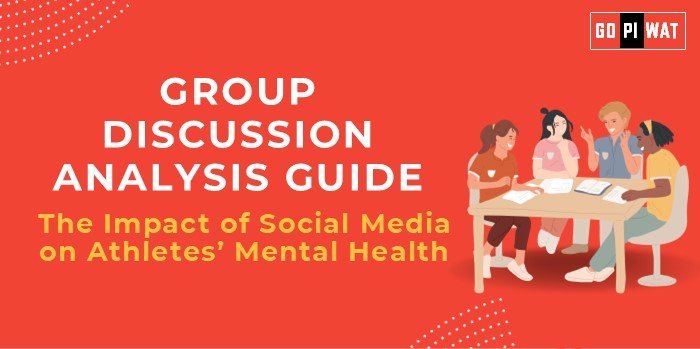📋 Group Discussion (GD) Analysis Guide: The Impact of Social Media on Athletes’ Mental Health
🌟 Introduction to the Topic
- 🌐 Opening Context: Social media, with its global outreach, has revolutionized communication, but it also exerts a profound influence on athletes, impacting their mental well-being. For B-school aspirants, understanding this intersection between technology and human psychology is critical.
- 📜 Topic Background: Over the last decade, platforms like Instagram, Twitter, and TikTok have become integral to athletes’ personal branding and fan engagement. However, incidents of cyberbullying, unrealistic expectations, and mental health struggles have spotlighted the challenges athletes face.
📊 Quick Facts and Key Statistics
- ⚠️ Online Harassment: 43% of athletes have reported being victims of cyberbullying (Sport Journal, 2023).
- 🧠 Mental Health Awareness: 78% of sports organizations globally have launched initiatives on mental health (Global Sports Alliance, 2022).
- 📱 Social Media Penetration: 91% of professional athletes actively use social media (Pew Research, 2023).
- 🏅 High Impact Events: Olympic gymnast Simone Biles’ withdrawal in 2021 highlighted social media’s role in mental health discussions.
🤝 Stakeholders and Their Roles
- 🏅 Athletes: Directly affected; face pressures of performance, public scrutiny, and social engagement.
- 🏢 Sports Organizations: Responsible for providing mental health resources and policies.
- 🎉 Fans and Media: Create both support systems and challenges through interactions.
- 💻 Tech Companies: Have the potential to implement stricter anti-cyberbullying measures.
- 👩⚕️ Healthcare Professionals: Support mental well-being through counseling and advocacy.
🏆 Achievements and Challenges
🎯 Achievements:
- ✔️ Increased Awareness: High-profile cases have driven mental health advocacy in sports.
- 🤝 Support Systems: Platforms like Calm and Talkspace partner with leagues to offer mental health resources.
- 🎊 Positive Fan Engagement: Social media fosters direct communication and builds athlete-fan relationships.
⚠️ Challenges:
- 🚫 Cyberbullying: Trolls and toxic comments affect athletes’ self-esteem.
- 🔍 Unrealistic Comparisons: Highlight reels foster a culture of inadequacy.
- 🔒 Privacy Breaches: Intense public scrutiny invades personal lives.
🌍 Global Comparisons:
• USA: Leagues like the NBA promote mental health through mandatory counseling programs.
• Japan: Some sports bodies regulate athletes’ social media usage during competitions to minimize distractions.
📄 Case Studies:
• Naomi Osaka: Withdrawal from the French Open due to mental health, partially attributed to media pressure.
💬 Structured Arguments for Discussion
- ✔️ Supporting Stance: “Social media offers athletes unparalleled fan engagement opportunities, fostering connections and amplifying their brand.”
- ❌ Opposing Stance: “Unregulated social media fosters toxic environments, severely impacting athletes’ mental health.”
- ⚖️ Balanced Perspective: “While social media is transformative, strategic policies and mental health support are essential to mitigate its downsides.”
📈 Effective Discussion Approaches
- 📝 Opening Approaches:
- Share impactful statistics (e.g., cyberbullying rates).
- Highlight a high-profile case (e.g., Simone Biles or Naomi Osaka).
- 💡 Counter-Argument Handling: Address benefits such as branding but propose stricter content moderation by platforms.
🔎 Strategic Analysis of Strengths and Weaknesses
• Strengths: Global reach, direct fan engagement, revenue generation.
• Weaknesses: Cyberbullying, unrealistic expectations, addiction.
• Opportunities: Partnerships with mental health apps, AI moderation tools.
• Threats: Privacy concerns, regulatory challenges.
🎓 Connecting with B-School Applications
• Real-World Applications: Links to digital marketing, personal branding, and corporate social responsibility.
• Sample Questions:
- 📌 “How can sports organizations use social media to balance marketing and mental health?”
- 📌 “Discuss the role of public relations in managing athletes’ online presence.”
• Insights for Students: Leverage social media responsibly, integrate digital strategy with well-being initiatives.


